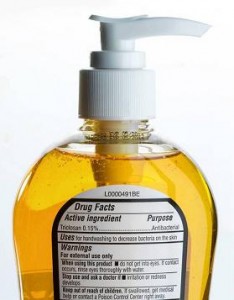
More evidence that low-calorie sweeteners are bad for your health
Studies show that artificial sweeteners can raise the risk of hypertension, metabolic syndrome, type 2 diabetes and heart disease, including stroke.

Natural Health News — Triclosan – a synthetic antibacterial widely used in personal care products – is fuelling the development of resistant bacteria in streams and rivers.
That’s the conclusion of a worrying new study published in the journal Environmental Science and Technology – the first to document triclosan resistance in a natural environment.
Invented for surgeons in the 1960s, triclosan slows or stops the growth of bacteria, fungi, and mildew. Currently, around half of all liquid soaps contain the chemical. It is also widely used in toothpastes, deodorants, cosmetics, liquid cleansers, and detergents. Triclosan enters streams and rivers through domestic wastewater, leaky sewer infrastructure, and sewer overflows, with residues now common in waterways throughout the United States.
Researchers from Cary Institute of Ecosystem Studies in Millbrook, New York, Loyola University and the Illinois Sustainable Technology Center, explored how bacteria living in stream and river sediments responded to triclosan in both natural and controlled settings.
Field studies were conducted at three sites in the Chicago metropolitan region: urban North Shore Channel, suburban West Branch Dupage River, and rural Nippersink Creek.
Urban areas = more triclosan pollution
Urbanisation was correlated with a rise in both triclosan concentrations in sediments and the proportion of bottom-dwelling bacteria resistant to triclosan. A woodland creek had the lowest levels of triclosan-resistant bacteria, while a site on the North Shore Channel downstream of 25 combined sewer overflows had the highest levels.
Combined sewers deliver domestic sewage, industrial wastewater, and storm water to a regional treatment plant using a single pipe. Overflows occur when a pipe’s capacity is exceeded, typically due to excessive runoff from high rainfall or snowmelt events. The result: untreated sewage flows directly into rivers and streams.
The research team found that combined sewer overflows that release untreated sewage are a major source of triclosan pollution in Chicago’s North Shore Channel. In addition, their findings support past work that indicates sewage treatment plants can effectively remove triclosan from wastewater.
Nearly 800 cities in the US rely on combined sewer overflows, with the Environmental Protection Agency citing them as a major water pollution concern.
Environmental impacts
John Kelly of Loyola University Chicago, the paper’s senior author, comments, “We demonstrated a strong link between the presence of triclosan in the environment and the development of triclosan resistant bacteria.”
In addition to the creation of these resistant bacteria, researchers also found a decrease in the diversity of benthic bacteria and a shift in the composition of bacterial communities. Most notable were a 6-fold increase in cyanobacteria and a dramatic die-off of algae.
Co-author Emma Rosi-Marshall, an aquatic ecologist at the Cary Institute of Ecosystem Studies in Millbrook, New York explains the damaging effect this can have on aquatic life: “Cyanobacteria are less nutritious than algae and can produce toxins. In triclosan-polluted streams and rivers, changes in microbial communities could negatively affect ecological function and animal communities.”
She adds: “The bacterial resistance caused by triclosan has real environmental consequences. Not only does it disrupt aquatic life by changing native bacterial communities, but it’s linked to the rise of resistant bacteria that could diminish the usefulness of important antibiotics.”

Please subscribe me to your newsletter mailing list. I have read the
privacy statement